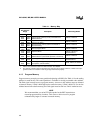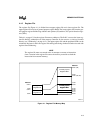
8XC196MC, MD, MH USER’S MANUAL
4-2
4.1.3 Program Memory
Program memory occupies a memory partition beginning at 2080H. (See Table 4-1 for the ending
address for each device.) This entire partition is available for storing executable code and data.
The EA# signal controls access to program memory. Accesses to this address range are directed
to internal memory if EA# is held high and to external memory if EA# is held low. For devices
without internal nonvolatile memory, the EA# signal must be tied low. EA# is latched at reset.
NOTE
We recommend that you write FFH (the opcode for the RST instruction) to
unused program memory locations. This causes a device reset if a program
unintentionally begins to execute in unused memory.
Table 4-1. Memory Map
Device and
Hex Address
Range
Description Addressing Modes
MC, MD MH
FFFF
6000
FFFF
A000
External device (memory or I/O) connected to the
address/data bus
Indirect or indexed
5FFF
2080
9FFF
2080
Program memory (internal nonvolatile or external
memory); see Note 1.
Indirect or indexed
207F
2000
207F
2000
Special-purpose memory (internal nonvolatile or
external memory)
Indirect or indexed
1FFF
1FE0
1FFF
1FE0
Memory-mapped SFRs Indirect or indexed
1FDF
1F00
1FDF
1F00
Peripheral SFRs
Indirect, indexed, or
windowed direct
1EFF
0200
1EFF
0300
External device (memory or I/O) connected to the
address/data bus (future SFR expansion; see Note 2)
Indirect or indexed
01FF
0100
02FF
0100
Upper register file (general-purpose register RAM)
Indirect, indexed, or
windowed direct
00FF
0000
00FF
0000
Lower register file (general-purpose register RAM,
stack pointer, and CPU SFRs)
Direct, indirect, or indexed
NOTES:
1. After a reset, the device fetches its first instruction from 2080H.
2. The content or function of these locations may change in future device revisions, in which case a pro-
gram that relies on a location in this range might not function properly.


















